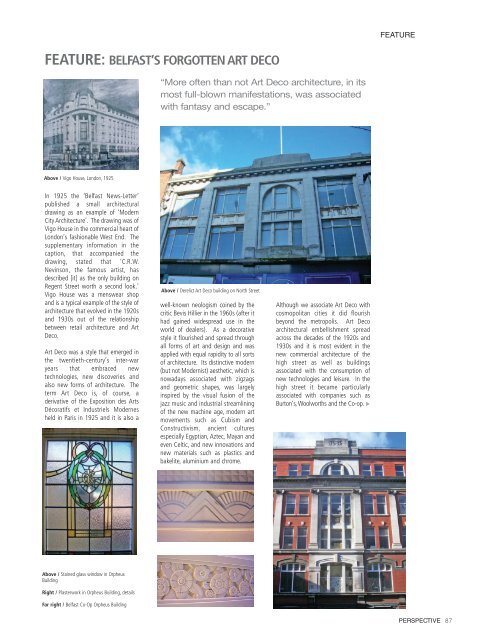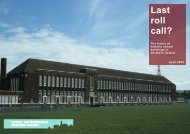Belfast's Forgotten Art Deco - Ulster Architectural Heritage Society
Belfast's Forgotten Art Deco - Ulster Architectural Heritage Society
Belfast's Forgotten Art Deco - Ulster Architectural Heritage Society
Create successful ePaper yourself
Turn your PDF publications into a flip-book with our unique Google optimized e-Paper software.
FEATURE: BELFAST’S FORGOTTEN ART DECO<br />
Above / Vigo House, London, 1925<br />
In 1925 the ‘Belfast News-Letter’<br />
published a small architectural<br />
drawing as an example of ‘Modern<br />
City Architecture’. The drawing was of<br />
Vigo House in the commercial heart of<br />
London’s fashionable West End. The<br />
supplementary information in the<br />
caption, that accompanied the<br />
drawing, stated that ‘C.R.W.<br />
Nevinson, the famous artist, has<br />
described [it] as the only building on<br />
Regent Street worth a second look.’<br />
Vigo House was a menswear shop<br />
and is a typical example of the style of<br />
architecture that evolved in the 1920s<br />
and 1930s out of the relationship<br />
between retail architecture and <strong>Art</strong><br />
<strong>Deco</strong>.<br />
<strong>Art</strong> <strong>Deco</strong> was a style that emerged in<br />
the twentieth-century’s inter-war<br />
years that embraced new<br />
technologies, new discoveries and<br />
also new forms of architecture. The<br />
term <strong>Art</strong> <strong>Deco</strong> is, of course, a<br />
derivative of the Exposition des <strong>Art</strong>s<br />
Décoratifs et Industriels Modernes<br />
held in Paris in 1925 and it is also a<br />
Above / Stained glass window in Orpheus<br />
Building<br />
Right / Plasterwork in Orpheus Building, details<br />
Far right / Belfast Co-Op Orpheus Building<br />
“More often than not <strong>Art</strong> <strong>Deco</strong> architecture, in its<br />
most full-blown manifestations, was associated<br />
with fantasy and escape.”<br />
Above / Derelict <strong>Art</strong> <strong>Deco</strong> building on North Street<br />
well-known neologism coined by the<br />
critic Bevis Hillier in the 1960s (after it<br />
had gained widespread use in the<br />
world of dealers). As a decorative<br />
style it flourished and spread through<br />
all forms of art and design and was<br />
applied with equal rapidity to all sorts<br />
of architecture. Its distinctive modern<br />
(but not Modernist) aesthetic, which is<br />
nowadays associated with zigzags<br />
and geometric shapes, was largely<br />
inspired by the visual fusion of the<br />
jazz music and industrial streamlining<br />
of the new machine age, modern art<br />
movements such as Cubism and<br />
Constructivism, ancient cultures<br />
especially Egyptian, Aztec, Mayan and<br />
even Celtic, and new innovations and<br />
new materials such as plastics and<br />
bakelite, aluminium and chrome.<br />
Although we associate <strong>Art</strong> <strong>Deco</strong> with<br />
cosmopolitan cities it did flourish<br />
beyond the metropolis. <strong>Art</strong> <strong>Deco</strong><br />
architectural embellishment spread<br />
across the decades of the 1920s and<br />
1930s and it is most evident in the<br />
new commercial architecture of the<br />
high street as well as buildings<br />
associated with the consumption of<br />
new technologies and leisure. In the<br />
high street it became particularly<br />
associated with companies such as<br />
Burton’s, Woolworths and the Co-op.<br />
▲<br />
FEATURE<br />
PERSPECTIVE 87
88<br />
PERSPECTIVE<br />
FEATURE<br />
BELFAST’S FORGOTTEN ART DECO<br />
Belfast was no exception to this<br />
trend and has rich examples of <strong>Art</strong><br />
<strong>Deco</strong> buildings made for such<br />
companies; all of which are presently<br />
at great risk.<br />
▲ Above / Sinclair's Department Store, Royal<br />
As the 1925 article in the ‘Belfast<br />
News-Letter’ pointed out Vigo House<br />
was a menswear store and the<br />
relationship between menswear and<br />
modernity, between male sartorial<br />
Avenue<br />
Right / Sinclair's Department Store, North Street<br />
style and the creation of physical<br />
spaces remains as hidden from history<br />
as the forgotten architecture that<br />
once encased it. The association<br />
between women’s fashion and such<br />
spaces is much better understood. In<br />
the 1920s and the 1930s the ‘Belfast<br />
News-Letter’ offered daily fashion<br />
advice for women and also published<br />
reports on the latest Parisian trends,<br />
which were available at Belfast’s<br />
great department stores such as<br />
Anderson & McAuley’s, Robinson &<br />
Cleaver’s, Arnott’s and even the Cooperative<br />
<strong>Society</strong> or Co-op as it was<br />
known.<br />
The store built for the Belfast Cooperative<br />
<strong>Society</strong> in 1932 by Samuel<br />
Stevenson, on York Street, is a key<br />
example of <strong>Art</strong> <strong>Deco</strong> architecture in<br />
the city. Known as the Orpheus<br />
Building Stevenson’s four-storey<br />
structure runs for much of the length<br />
of York Street until near to its<br />
intersection at Frederick Street. The<br />
restrained façade of red-brick hides<br />
much exuberant <strong>Art</strong> <strong>Deco</strong> decoration<br />
inside. From the wainscot woodpanelling<br />
and stained glass on the<br />
central stairwells to the remarkable<br />
stucco plasterwork, with zigzag,<br />
sunburst and floral motifs, on the<br />
wonderfully curved and gorgeously<br />
Left / Former Burton's shop, Ann Street<br />
Below / <strong>Art</strong> <strong>Deco</strong> decoration on Burton's façade<br />
white ceiling of the Orpheus ballroom<br />
on the top-floor of the building. This<br />
building acted as an extension for the<br />
Belfast School of <strong>Art</strong>, located on the<br />
opposite side of York Street, since the<br />
closure of the Co-op in the late 1980s.<br />
It is now the city campus for the<br />
University of <strong>Ulster</strong>, who recently<br />
revealed major redevelopment plans<br />
for the campus including the razing of<br />
all but the Orpheus building’s façade.<br />
Already the uniqueness of the<br />
Orpheus ballroom has been largely<br />
lost by its division with a rather<br />
unsightly mezzanine floor to<br />
accommodate more students. The<br />
loss of perhaps one of the city’s most<br />
important <strong>Art</strong> <strong>Deco</strong> interiors is<br />
indicative of how the remarkable<br />
architecture of the period is treated in<br />
twenty-first century Belfast.<br />
In 1930 the psychoanalyst J.C. Flügel<br />
may have published his theory of ‘the<br />
great masculine renunciation of<br />
fashion’ in his ‘The Psychology of<br />
Clothes’ but in the 1920s and 1930s<br />
many of the new <strong>Art</strong> <strong>Deco</strong> spaces<br />
created in response to the increasing<br />
consumption of fashion were for<br />
spaces for the selling of menswear.<br />
Best known of all the high street<br />
companies is perhaps Burton’s,<br />
founded as a retailer selling<br />
readymade men’s suits, by the<br />
entrepreneur Montague Burton, just<br />
after 1900. Belfast got its first<br />
purpose-built Burton’s menswear<br />
store in 1933. The building on the<br />
corner of Ann Street and Telfair Street<br />
was designed by Harry Wilson of<br />
London. It is a three-storey <strong>Art</strong> <strong>Deco</strong><br />
building with a remarkable decorative<br />
faïence façade which includes stylized<br />
geometric patterning derived from<br />
Egyptian design and two elephants<br />
heads crowning the columns. Few<br />
Burton’s buildings had such ornate<br />
▲<br />
decoration which surely singles this<br />
out as worth saving. The Burton’s store<br />
on Greenwich’s Nelson Street, southeast<br />
London, built in 1932, has similar<br />
elephant head decorations. The<br />
building on Belfast’s Ann Street has<br />
been derelict for several years, it has<br />
lost its distinctive façade lettering but it<br />
is still recognizable as a vestige of its<br />
former glory.<br />
▲<br />
Several other <strong>Art</strong> <strong>Deco</strong> buildings in the<br />
vicinity also presently languish. The<br />
former Sinclair’s department store on<br />
the on the junction of Royal Avenue and<br />
North Street has been vacant for several<br />
years. Designed by James Scott in 1935<br />
its façade on North Street today is hardly<br />
recognizable as part of a former major<br />
department store on a prestigious large<br />
corner site in the city centre. Along<br />
North Street many other buildings from<br />
the 1920s and 1930s are slowly sinking<br />
into rack and ruin. The Bank of Ireland<br />
on the opposite corner to Sinclair’s on<br />
the junction of Royal Avenue and North<br />
Street, completed in 1930 by Joseph<br />
Downes of McDowell and Dixon of<br />
Dublin, is a sad spectre of its former self.<br />
It distinctive <strong>Art</strong> <strong>Deco</strong> tower, metal<br />
fenestration, metal doors, figurative<br />
carving and lettering all remain intact<br />
but it looks more and more vulnerable in<br />
its derelict state. Similarly, Thomas<br />
Rippingham’s remarkable Telephone<br />
House and Central Telephone Exchange<br />
on the corner of Cromac Street and May<br />
Street (1932-34), with its striking<br />
electric bolt decorative motifs, also looks<br />
worryingly empty and defenceless.<br />
Not all of Belfast’s <strong>Art</strong> <strong>Deco</strong> architecture<br />
is uncared for and forgotten. The King’s<br />
Hall at Balmoral on the Lisburn Road,<br />
built by A. Leitch & Partners, London<br />
and Glasgow for the Royal <strong>Ulster</strong><br />
Agricultural <strong>Society</strong> (1933-34), Whitla<br />
Above / Former Woolworth's building on High Street<br />
Right / Bank of Ireland, Royal Avenue<br />
Below / Bank of Ireland, detail<br />
Hall at Queen’s University by McGeagh<br />
and Edward Maufe (1937 and<br />
competed after the war), and the Floral<br />
Hall at Belfast Zoological Gardens on<br />
the Antrim Road, built by David Boyd<br />
(1935-6) are all good examples of how<br />
well such architecture can function in a<br />
contemporary way.<br />
More often than not <strong>Art</strong> <strong>Deco</strong><br />
architecture, in its most full-blown<br />
manifestations, was associated with<br />
fantasy and escape. Cinemas<br />
embodied this more than any other<br />
form of architecture and although a<br />
few of Belfast’s cinemas from the<br />
inter-war years survive some, such as<br />
the Curzon on the Ormeau Road and<br />
the Strand on the Holywood Road,<br />
Above / Detail of <strong>Art</strong> <strong>Deco</strong> decoration on<br />
Telephone House, Cromac Street<br />
both designed by James Neill in the<br />
1930s, survive as examples of<br />
cinema’s ‘glorious age’. Others such<br />
as the Stadium on the Shankhill Road<br />
now partly survives as a leisure centre,<br />
and the Ritz built by Kemp and Tasker<br />
of London in 1935 maintained its role<br />
as a cinema well into the late<br />
twentieth century becoming the ABC<br />
but was recently demolished to make<br />
way for a hotel.<br />
These examples show how the saving<br />
of such <strong>Art</strong> <strong>Deco</strong> architecture adds<br />
much to our contemporary built<br />
environment and much more needs to<br />
be done to ensure the survival of<br />
those <strong>Art</strong> <strong>Deco</strong> structures that are still<br />
standing. The largest <strong>Art</strong> <strong>Deco</strong><br />
building in Belfast’s city centre that<br />
four-storey store built for Woolworth’s<br />
on High Street in 1930 by F.W.<br />
Woolworth & Co. of Liverpool, the<br />
giant pilasters with Egyptian<br />
decoration are explained by the fact<br />
the Burton’s also had premises on this<br />
large site between the 1930s and the<br />
1990s, still functions as a major shop<br />
(for the Irish chain Dunnes). This<br />
edifice, in many ways, recalls an age<br />
as well as types of buildings, types of<br />
shops and modes of consumption,<br />
which are now almost extinct.<br />
Belfast’s <strong>Art</strong> <strong>Deco</strong> buildings, as such,<br />
are more than vestiges of an age gone<br />
by but tangible remnants of culture<br />
that is now falling out of<br />
living memory.<br />
Joseph McBrinn<br />
FEATURE<br />
PERSPECTIVE 89











